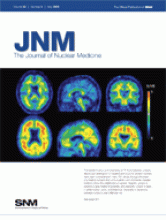TO THE EDITOR: In a recent PET/CT article, Dr. David Townsend concludes with the opinion that software fusion as a clinical approach to diagnostic PET is simplistic when compared with the commercially and academically preferred solution of the hybrid scanner (1). I respectfully counter that the bulk of the literature has taken a simplistic and incomplete view of software fusion where costs and compromises inherent in hybrid imaging have blunted the optimal use of PET.
The basis of this letter is a review of the published literature and over 5 y of experience with automatic and manual software fusion of PET with CT and MRI, including 4 y using a predefined alignment protocol and end-expiratory-phase CT acquisitions. This protocol has permitted representative diagnostic fusions of CT and MRI with Na18F bone scans for publication (2). Our workstations have been Fusion 7D (Mirada) and Syntegra (Philips), with limited but equally successful experience with MIM (MIMvista) and Medview (MedImage).
In 733 consecutive patients and 921 lesions, Buell et al. concluded that in 93% of cases, PET alone or PET in conjunction with side-by-side CT studies were fully diagnostic (3). Putting aside the aesthetics of coregistration, how to approach this 7% of patients has been the arena of debate for software versus hardware fusion.
The diagnostic success of software fusion hinges on the respiratory phase for the CT portion, attention to patient alignment, and the selection of uniformly successful software algorithms. Studies with poor or unsuccessful software fusion universally compared PET/CT, with its same-day acquisition, diagnostic coregistration, and end-expiratory-phase CT, against software fusion, which characteristically used noncoordinated studies, no predefined positioning protocols, and entirely disparate respiratory phases (4). These scanning parameters create an insurmountable barrier to consistent software-fusion success. Why should not stand-alone PET and CT studies use protocols that are both integral and necessary for successful PET/CT? Without comparing similar imaging strategies, these studies have only compared apples with oranges.
Articles on successful software fusion have emphasized patient positioning, and all have used end-expiratory-phase CT. The review by Nakamoto et al. of 63 patients with recurrent colorectal cancer showed similar qualitative outcome versus the hybrid by using manual fusion with whole-body CT scans (5). Senda et al. showed manual fusion to surpass the hybrid for suspected recurrent lung cancer (6). Studies by Krishnasetty et al. showed an equal diagnostic outcome for stand-alone PET and CT in the evaluation of the thorax when alignment and respiration phase mimicked the hybrid (7). Whole-body MRI fusion with PET by Yoshidata et al. were fully diagnostic for the body, with only the head area requiring additional fusion (8). MRI and PET have identical breathing patterns. For these MRI fusions, a maximum mutually weighted automatic fusion was used. Decoupled from attenuation correction, CT and MRI do not need as precise a coregistration, thus providing more latitude for diagnostic fusion with low-resolution PET.
Poor automatic fusion of stand-alone PET and CT scans can result from poor patient alignment or insufficient information density for the computer program to fuse studies. The literature has not differentiated between fusion software failure and the failure of software fusion due to poor patient realignment (4). Thus, globally lumping all failures together obscures any true success of software-based coregistrations, particularly when more advanced algorithms are available.
Stand-alone PET and PET/CT scanners that retain and use on-board high-energy transmission sources historically obtain accurate and reproducible standardized uptake values (SUVs) permitting relevant assessment of response to therapy (9). For esophageal cancer, Bruzzi et al. at M.D. Anderson Cancer Center experienced hybrid SUV errors of 30%−50%, which precluded assessment of response to therapy (10). Errors of 25% in SUVs have been published by Erdi et al. for respiratory mismatching of lung lesions (9). The literature is replete with forms of segmental breath-holding, list-mode, and gated acquisitions to overcome these errors, adding compensatory routines with further layers of complexity and radiation (10).
Radiation exposure from the requisite CT attenuation of PET/CT is significant, sometimes greater than the 18F-FDG injection (11). Lowest-dose CT attenuation requires 1.3 mSv, whereas 137Cs and 68Ge sources deliver 11–30 μSv (11,12). Higher-definition CT studies can require 8.8–18.9 mSv (12); 175–370 MBq of 18F-FDG impart only 2.8–7.0 mSv (12). Often, only attenuation correction is needed for the second portion of a dual-time-point acquisition, for 18F PET bone scans (particularly the blood pool phase), and may be sufficient for studies of certain cancers. A recent communication suggested that hybrid CT be limited prospectively to only high-yield areas of the body, reducing needless exposure (13).
Presently, comparisons of the economics of scanner acquisitions are skewed because of the absence of new stand-alone PET scanners. A used PET scanner and fusion workstation have a tremendous cost advantage over new or used PET/CT hybrids if there is a preexisting CT or MRI scanner. It is difficult to extrapolate the relative cost of building new stand-alone scanners when new low-priced hybrids cost about the same as a previous high-end stand-alone PET scanner.
There has never been a comprehensive assessment of software fusion. Continued use of software fusion is not beating a dead horse; rather, it challenges the industry's premature euthanasia of a viable and economical imaging pathway. Combining a used PET scanner and software fusion with preexisting CT and MRI reduces the inventory of equipment and costly service contracts while offering renewed opportunities to advance PET, especially in underserved areas and under increasing economic constraints. Accurate and reproducible SUVs, attenuation correction that is impervious to CT contrast material and metal artifacts, and the ability to reduce radiation exposure are valuable and versatile qualities of software fusion with pure PET scanners.
In conclusion, software fusion is not necessarily a simplistic approach to PET interpretation. Expanding the availability of PET in these challenging times requires reevaluation and appreciation of our imaging assets and options as well as acknowledgment of the true capabilities both of hardware and of software solutions.
Footnotes
-
COPYRIGHT © 2009 by the Society of Nuclear Medicine, Inc.







